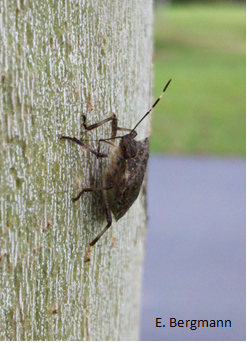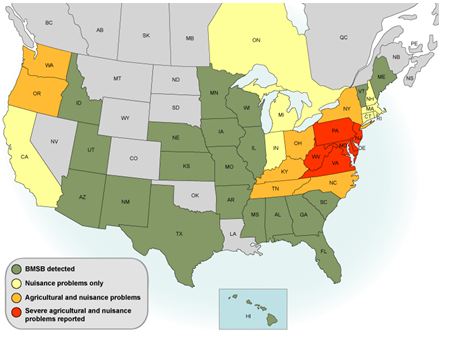|
The brown marmorated stink bug (BMSB) has been the bane of both farmers and homeowners for the past decade. These invasive pests, native to eastern Asia, have an incredibly broad host range that encompasses a wide array of food crops and ornamentals. Much work has been done on the damage BMSB can do in vegetable and field crop systems by faculty members Galen Dively and Cerruti Hooks. Speaker Erik Bergmann's work has instead focused on ornamental systems, worth an estimated $2 billion annually in Maryland alone. By looking at host use by BMSB, Erik hopes to find a way to essentially 'design' these insects out of landscapes. Representing two years of research, the data set that Erik has assembled is truly colossal. Over 5,000 individial plants were surveyed nearly 54,000 times with 34,000 insects counted overall. While looking at host plant use is nothing new, Erik's study is the first of its kind to look at BMSB host use at the cultivar level, information which is significantly more useful to growers than broad generalizations about plant species or genera. Cultivars can be thought of as breeds or varieties of a plant species that differ from one another in a number of ways, such as appearance or hardiness. By learning which cultivars are more susceptible to stink bug attack, growers can plant the species or genus they desire and minimize BMSB damage. While very polyphagous, BMSB does show some host preference. By looking at the use of different plant cultivars by different life stages of BMSB, Erik was able to determine which plants were preferred by BMSB. Several striking trends became apparent. First, BMSB vastly preferred angiosperms to gymnosperms. Second, they generally preferred non-Asian hosts to Asian hosts. However, this sometimes differed from genus to genus. For example, BMSB preferred Asian over non-Asian cedars but preferred non-Asian over Asian pine cultivars. Two hypotheses seek to explain this preference for Asian or non-Asian plant cultivars. The first, known as the enemy release hypothesis, posits that insects will eat plants that are familiar to them and exist in their native range. An alternative hypothesis (and one that Erik believes more likely in the case of BMSB) is known as defense free space, which suggests that insects will take advantage of plants that cannot defend themselves from attack. Armed with the knowledge gained from this research, hopefully greater effort can be made to employ cultural control practices to design the brown marmorated stink bug out of our farms and out of our landscapes. About Thomas:
Thomas Pike is a second year masters student in Paula Shrewsbury's lab conducting research on ornamental IPM. His primary research focus is on the effects of entomopathogenic fungi on the brown marmorated stink bug and their potential as a biological control. Comments are closed.
|
Categories
All
Archives
June 2024
|
Department of Entomology
University of Maryland
4112 Plant Sciences Building
College Park, MD 20742-4454
USA
Telephone: 301.405.3911
Fax: 301.314.9290
University of Maryland
4112 Plant Sciences Building
College Park, MD 20742-4454
USA
Telephone: 301.405.3911
Fax: 301.314.9290



 RSS Feed
RSS Feed




